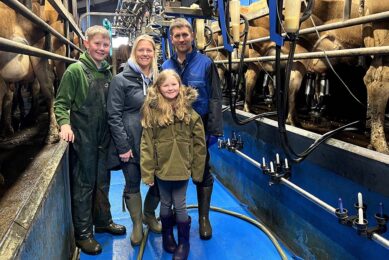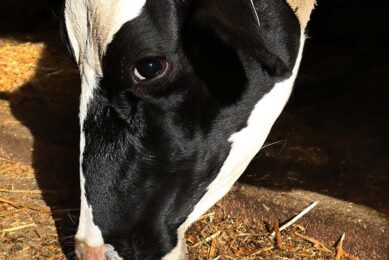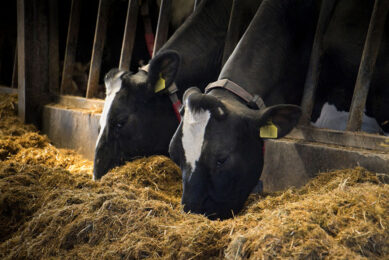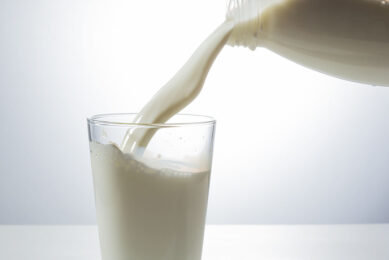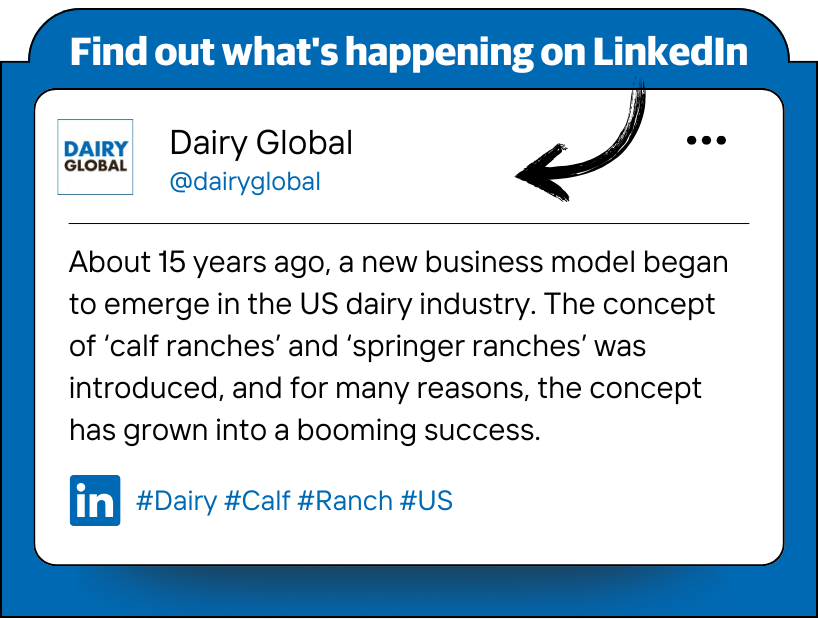Dairy farmer in Scotland keeps costs low but uncertain about succession
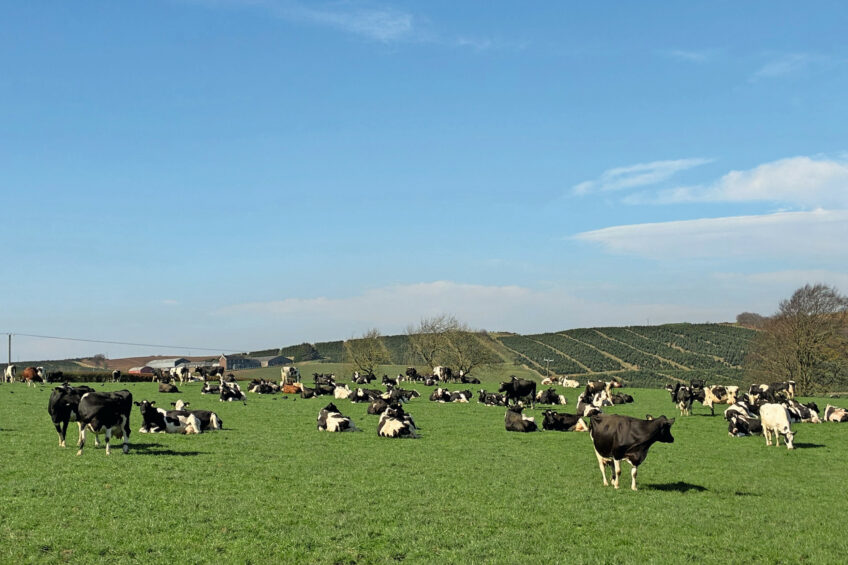
The farm’s operating profit is structurally around €350,000 per year, so there is no reason for Jim Baird to worry. But whether he will find a successor for his company remains to be seen as growth is very restricted at the current location.
Jim Baird’s cows always have a solid floor on the way to the pasture. There is a 700 m concrete path from the stables to the fields. In the pastures, there is a strip of artificial grass, 2 m wide, towards the end of the field. “We work with strip grazing using electric fences,” said Jim. “The cows get a fresh strip of grass twice a day after each milking. We then back fence to prevent them eating the fresh regrowth,” explained the cheerful Scot. “The artificial grass provides a solid path through the field and easy access if the weather is unfavourable.”
Grass growth and pasture
The cows access the pasture when there is just under 3,000 kg of dry grass. After 2 days of strip grazing, that is reduced to 1,500 kg. Jim goes through the pastures every week with the grass plate metre. “It is important to start grazing on time to be able to set the rotation,” he says from experience. This year it is going perfectly – the cows went onto pasture on 14 March, 2 weeks before the estimated date of 1 April. “We have had a really good early spring; the grass started growing on time.”
Jim only grows grass, 104 ha. About half is for forage production, the other half for grazing. The yield is about 12 tonnes of dry matter per year in 4 or 5 cuts. He outsources the mowing and chopping to a contractor. “We do have a mower, but that is to clear a plot once in a while. The contractor works with a triple mower – that’s a lot of capacity at low costs.” Ensiling around 40 hectares at a time takes 5 hours. “The contractor chops. We drive it to the pit ourselves because we have the tractors and silage wagons anyway.”
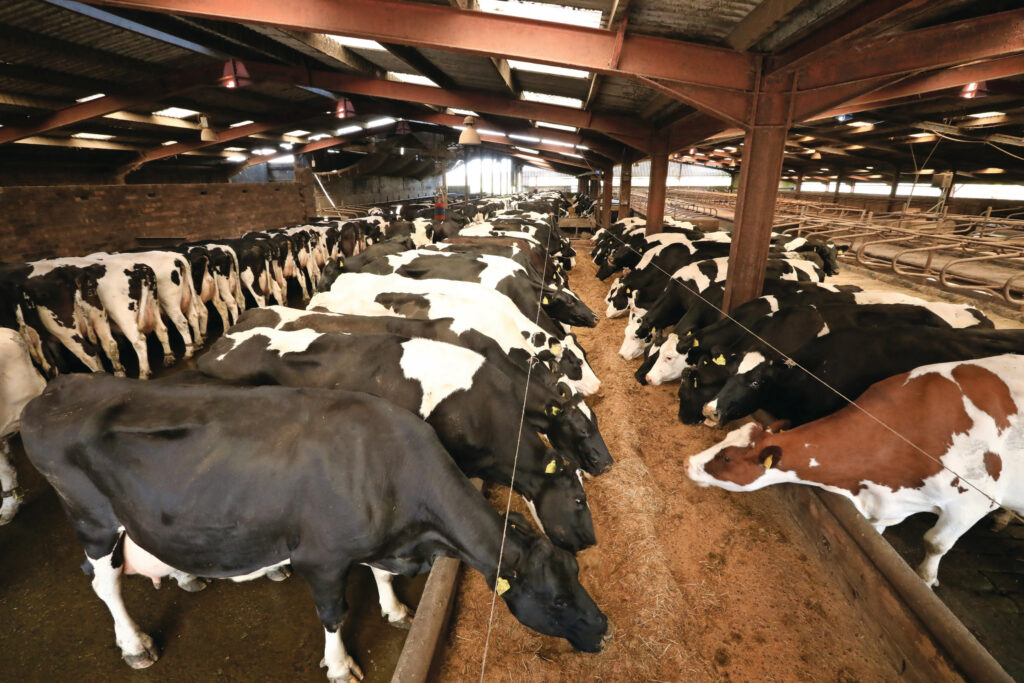
All liquid manure is stored outside the barns and spread by a contractor. This is supplemented with around 115 kg of nitrogen from artificial fertiliser per hectare per year, in 4 or 5 applications between February and the end of August. “We have 6,000 cubic metres of storage and we spread all the liquid manure during the growing season. In this region, you can still spread it all year round. In other parts of Scotland, law requires this be done only during the growing season, from February to mid-September. Such requirements are likely to come here at some point. We are ready for it; we can store for more than half a year.”
Low costs in all areas
Despite a lot of outsourcing, Jim’s contractor costs are low at 1.9 cents per kg Energy Corrected Milk (ECM). That is almost 50% less than the average of the English EDF members. Jim’s total costs for labour and machinery are 16.7 cents per kg ECM, which is 2.8 cents below the average.
Almost all costs are a fraction below the average (see Table). Ultimately, that does add up. The total costs from April 2023 to March 2024 were 45.4 cents per kg, which was 8.7 cents below average. Note that the average company has 350 cows – Jim milks 234.
On the revenue side, things are less rosy. Jim supplies First Milk, and that party has not been able to keep up in recent years. In the 2024 financial year, he received 52.6 cents per kg of milk, which was 1.5 cents less than the average EDF producer in the United Kingdom. “The cooperative has now made clear choices. It is fully committed to regenerative agriculture. In doing so, it looks beyond just calculating CO2 emissions, because that is too narrow a focus. The co-op, with 700 dairy farm members, encourages refraining from ploughing, improving biodiversity, healthy soils and healthy cows. Everything should be measurable, to be recorded in scores. This method fits in very well with our farm and now earns us a few cents per kg of milk in bonuses. We are now above the EDF average again.”
Succession uncertain
Jim is a second-generation dairy farmer at this location. His father bought it in 1962 and bought a second farm a few kilometres away in 1982. That was converted into a second dairy unit in 1995. Jim’s brother was in charge there. In 2022, the brothers split up; both companies were relatively debt-free and were almost the same size. “My brother and I both had daughters looking to join the business, and it was the right time to go and do our own thing.”
Jim farms with his daughter Caroline (32) and wife Joyce (60). According to him, Caroline is good with the cattle, and she is also good at organising practical matters and managing people. “But she’s not eager to be an entrepreneur. The business needs a thinker. So that’s a priority going forward. We may have to hire an external coach, or a good business advisor to support her in this. Another option is a form of sharemilking like in New Zealand. We’ll have to think about that in the coming years.”
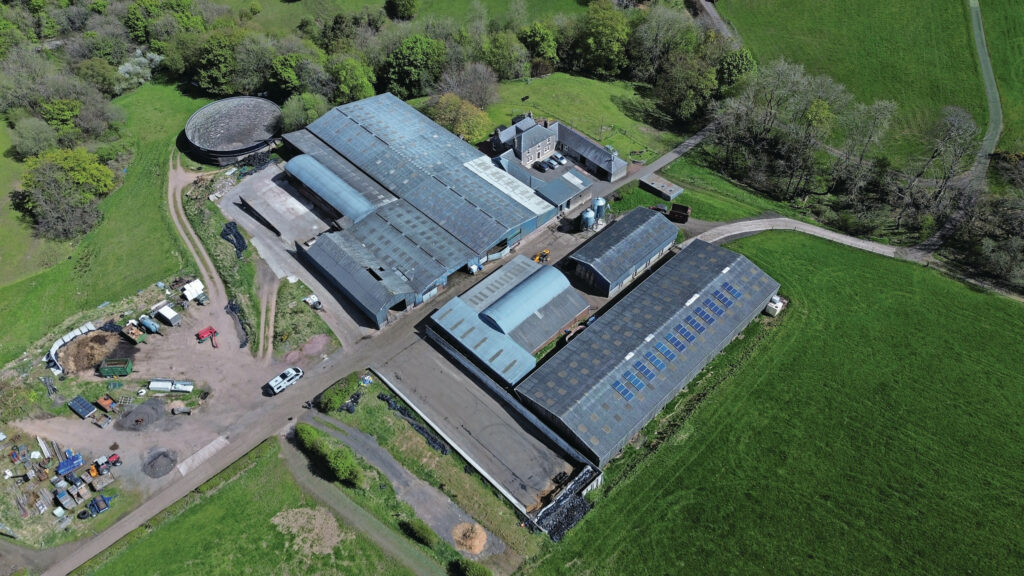
In addition, the rapidly changing British tax legislation is also getting in the way of entrepreneurs. “Previously, you could pass on a farm to the next generation without inheritance tax. Now, for amounts above the equivalent of €1.2 million, this tax relief has been cut, and family-owned businesses now face 20% tax on transferred assets. That poses a considerable tax burden with our company value of around €3.5 million. What’s more, the company is free of financing other than a small private loan from Jim’s parents, less than a €100,000.”
Growth is virtually impossible
The operating profit is structurally around €350,000 a year. The current 234 cows will be enough for the coming years, but Jim realises that he will have to counter inflation in costs with growth in production volume at some point. However, growth is virtually impossible at the current location, not because of permits, but because Jim sees further intensification than the current 2.8 LU per hectare as impractical. There is hardly any land for sale in the area. “I might knock on a few neighbours’ doors in the coming years to see if we can expand by purchasing land nearby. But, at the moment the business is in good balance and is operating at a sweet spot in terms of output and efficiency.”
Robotic milking is not on the agenda at the moment. “Attracting labour is not a problem. We have 1 permanent employee and 2 relief milkers, and although I am not against technology, I am certainly not crazy about it.” Jim also does not want to give up the flexibility that the 2×20 swing over offers.
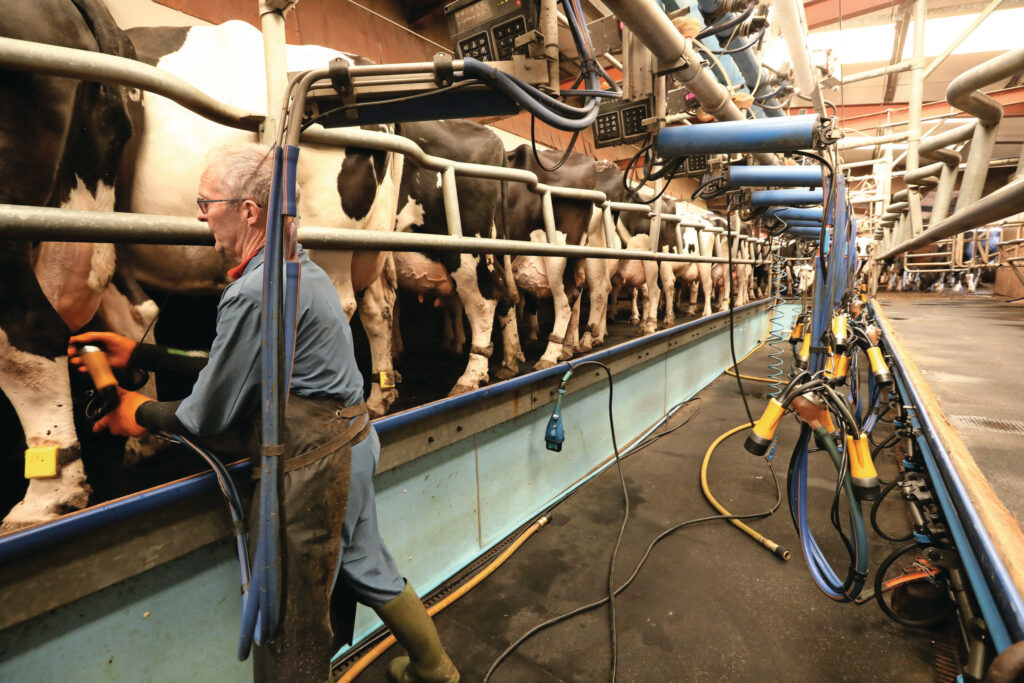
What about increasing the production volume? The current production is around 8,400 kg per cow with 4.33% fat and 3.46% protein. “I am not looking for 10,000 kg per cow,” said Jim. “Low costs through maximum use of our own grass is the priority.”
The New Zealand cow suits him best: frugal and capable of producing a lot of milk from grass. “We did crossbreed with Holstein here; the litres came but the sustainability disappeared. These are not easy cows to work with. We now work with NZ black and white and cross them with Montbéliarde, Norwegian red and a dash of Holstein. That way we keep an easy, ‘middle of the road’ cow that does what we want: calves within our block and doesn’t give us any problems.”
Systematic work, clear focus
The farmer also holds several board positions, “I would get bored if I didn’t have that,” he said. Systematic work on the farm is therefore crucial. The cows go into the barn at calving around October – winter comes early in Scotland. The animals are then fed a TMR ration of grass silage supplemented with grains from the whisky malt houses and 1,700 kg of concentrated feed per cow per year.
The calving season is from October until Christmas, followed by 3 months of insemination season. The first month with sexed semen on the better cows for the production of replacements, and Wagyu semen on the rest for the highest calf prices. The second month insemination takes place with Aberdeen Angus semen, the last month a few Aberdeen Angus bulls that walk around with the cows.
The farmer fattens the Angus crosses himself until they are about 5 months old. In early April they are sold in one go. Two traders and regional auction markets then make a bid per head.
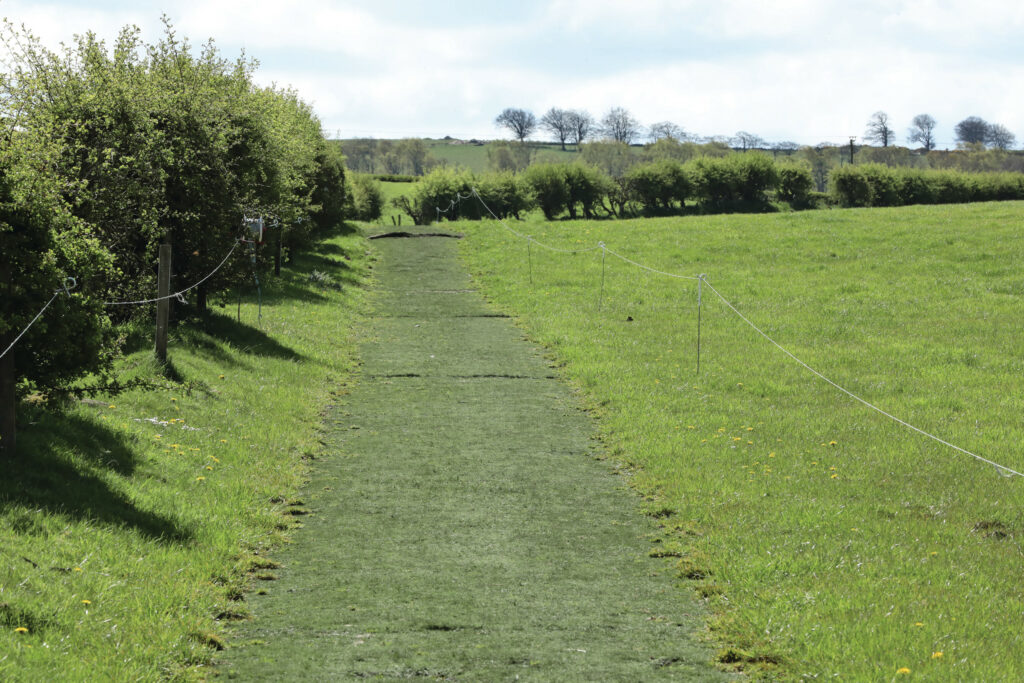
Most years, the fattening is more than cost-covering but doesn’t leave a huge margin. “This year is exceptional. The 136 cross calves sold brought in more than €137,000 because of the high meat prices – almost 60% more than last year.” He has not worried about security of payment. “Good that you mention that because now it really is a lot of money that’s being taken from the company at once.”
The grazing season starts around 1 April. Initially the cows are outside for just 12 hours, then as grass growth increases, they are fully grazed. Supplementation is fed via a TMR in bunkers before the evening milking. “During the summer our focus is entirely on efficient grassland management and making high quality silage.” The silage is stored in 2 trench silos. The first measures 60×15 m, the second shares a wall with the cubicle barn. This silo is 80×15 m and partly covered. This limits the ensiling height to about 5 m. Baird ensiles about 50 cm of distillers grains at the bottom, with the grass silage placed on top.
Project development for the future
In the coming years, Jim will mainly invest his money in project development. First a new house for himself and his wife Joyce. “At a build cost of €850,000, we will have to go to the bank – though it would certainly help if the milk price remains at this high level, of course.”
In addition to his own new house, Jim has permission to build 6 more houses, and given the location, with a phenomenal view over the Clyde valley, a lot of profit can be generated from that. “We had to apply for a house, so why not a few more? To our surprise, we were granted 7 permits. These permits remain valid ‘forever’ as long as construction of the first one has started. We want to live there by summer next year. The profit from the houses to be built later can be used to settle inheritance taxes and buy out the 2 other children if Caroline goes through with the takeover.” Jim himself wants to continue farming for another 10 years or so. “But maybe for fewer hours a day.”



